The connection between fashion and technology consists of a lot more than smart clothing and wearables. This is also a matter of new processes, innovative materials and unprecedented forms.
Marty McFly might have landed in the future on — October 21, 2015–but it took 31 years after the movie was made, to have Marty’s self-lacing sneakers. Nike announced their power lacing Hyperadapt 1.0 on December 1st, 2016 for a retail price of $720 and didn’t release them until mid 2018.
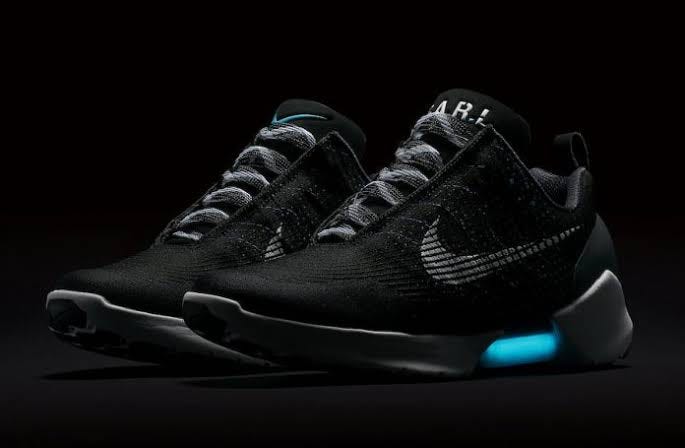 “Hyperadapt 1.0 a shoe that comes to life when you put it on. It lights up. It senses you. It adjusts to the shape of your foot and activity in real time. You run, it runs. You jump, it jumps. It’s a revolution disguised as a robot, disguised as a self-lacing shoe.” — NIKE.COM
“Hyperadapt 1.0 a shoe that comes to life when you put it on. It lights up. It senses you. It adjusts to the shape of your foot and activity in real time. You run, it runs. You jump, it jumps. It’s a revolution disguised as a robot, disguised as a self-lacing shoe.” — NIKE.COM
The innovation behind the sneaker was Nike’s E.A.R.L. (Electric Adaptable Reaction Lacing) the technology that makes self-lacing shoes possible. It electronically adjusts the lacing, pressure and fit to the contours of your foot. Their lemma “No loose laces. No distractions.”
This year, Nike announced “the shoe of the future”, the Nike Adapt Huarache shoe, a shoe you can control with Siri; which features the company’s “FitAdapt” technology, to let you adjust the fit of the shoe through Siri or your Apple Watch. Yep, there’s no need to be able to touch your toes anymore, a huge win for those of us who can’t or just don’t want to, thank you very much.
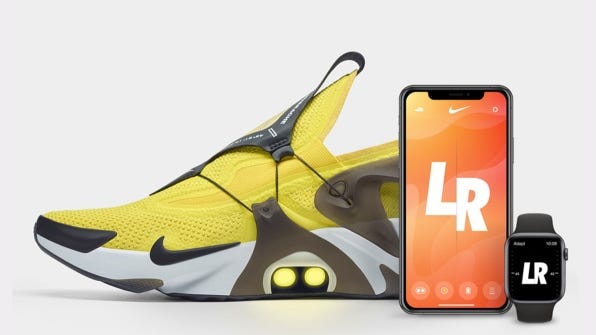
The very futuristic feature is an extension of the footwear we were promised first in Back to the Future Part II and then again in 2016, when Nike made self-lacing shoes a reality with the HyperAdapt 1.0. Now, the shoes, which are meant to accommodate a range of foot types and shoe preferences, are getting even more high-tech. In addition to the LED lights featured in earlier versions, the Adapt Huarache links the FitAdapt lacing system on your high-tech Nikes to Siri Shortcuts or your Apple Watch app.
The Nike Adapt Huarache is the first iteration of the shoe to connect the Nike app so it can tighten or loosen the shoe based on user control. Those controls include speaking to Siri on your iPhone (“Hey Siri, loosen my left shoe for me”) or by using the Apple Watch app. Both offer preset modes for custom fits, and there is also support for Siri Shortcuts for even easier control over the laces and presumably so you can ask your Home Pod to untie your shoes because you’ve used all your energy during your workouts. All you have to say is “Hey Siri, release my shoes”. The Adapt Huarahce is available for a retail price of $350 USD.
After these different high-tech sneaker iterations what’s the real innovation behind every sneaker? The End of Shoelaces? The present world without shoelaces currently ranges from $350 — $720 USD. (That is if you don’t buy from any reseller which in that case can go beyond the $1,000 USD).
These developments focused on the sneaker culture are interesting. But after all of these years, where is the famous Marty McFly self drying jacket?
Back in 2011, Back to the Future and the idea of having the self drying jacket was our main source of inspiration to jumpstart our brand. Our vision was to create a brand that would design slick functional products with technology embedded at a reasonable cost.
Our first creation: The MIDI Controller Jacket (MJ v1.0) — The first jacket that allows the user to create music through motion and touch sensors with a mobile app. Imagine being able to create music by using your body as an interface. Imagine being able to extend that jacket to make it work not only with music, but with whichever devices you have. This was our motto.
After many years of different iterations of our MIDI Controller Jacket, we no longer have it available. It is a product that has evolved into a more sophisticated piece of clothing. You can read all about our research and development process on our MIDI Controller Jacket here.
OUR MIDI CONTROLLER JACKET IS NO LONGER AVAILABLE BUT YOU CAN FIND ALL OF OUR AVAILABLE PRODUCTS HERE — NOW AVAILABLE
Innovating in the apparel industry is hard! It takes time, it takes money, and an endless ride of tweeking over each product development. Back to The Future being such major inspiration to us, when we first started, and to the vision that we have by innovating in the fashion industry had us jump start our first “wearable” — which took us six years to design and develop a jacket that could make music when you move. And it is still a product that we are currently getting feedback from our users. You can read more about the our MIDI Controller Jacket development here.
The term “fashion-tech” may be around 10 years old. But people having been trying to innovate in fashion and apparel far longer than that.
HISTORY
There have been many innovations throughout history that have moved fashion and clothing forward. These inventions have had a significant impact on the way we wear clothes.
Embroidery, featherwork, knits, floral appliques, pleating, lacework, tailoring, leatherwork, laser cutting, ultrasonic welding and more! have all been part of the fashion technology revolution. We might not recognize at first instance but technology has always been the essence of fashion…the fast-paced progress of technology complements fashions ever-evolving aesthetic, and each gives the other a wider frame of reference and more scope to explore new horizons.
Avant-garde practices in fashion cannot be consumed as easily or as quickly as mainstream fashion. This is because ‘to be in the avant-garde is to be in a perpetual state of rebellion’ against what is accepted as the mainstream. If building fashion technology techniques was to be easy, everybody would be doing it.
Digital technology continues to transform the promotion, fabrication, and basic design of fashion. From new material advancements and other advancements in sewable electronics, designers are creating garments that can play music, answer telephone calls, and even monitor the wearers heartbeat.
Avant- garde fashion requires a consumer segment that is more intellectually endowed. Thus, instead of looking fashionable, avant-garde fashion requires comprehending the incomprehensible, understanding what is being challenged and how it is being challenged.
1900’s onward The birth of handmade and the machine-made clothing.
Elsa Schiaparelli — Italian fashion designer known as one of the most prominent figures in fashion between the two World Wars. One of the basic innovations generated in the fashion scenario by Schiaparelli lies in the way the avant-garde designer blends art and garment construction. The unusual creations of Schiaparelli have challenged the fashion of her time and generated innovation in the fashion scenario.
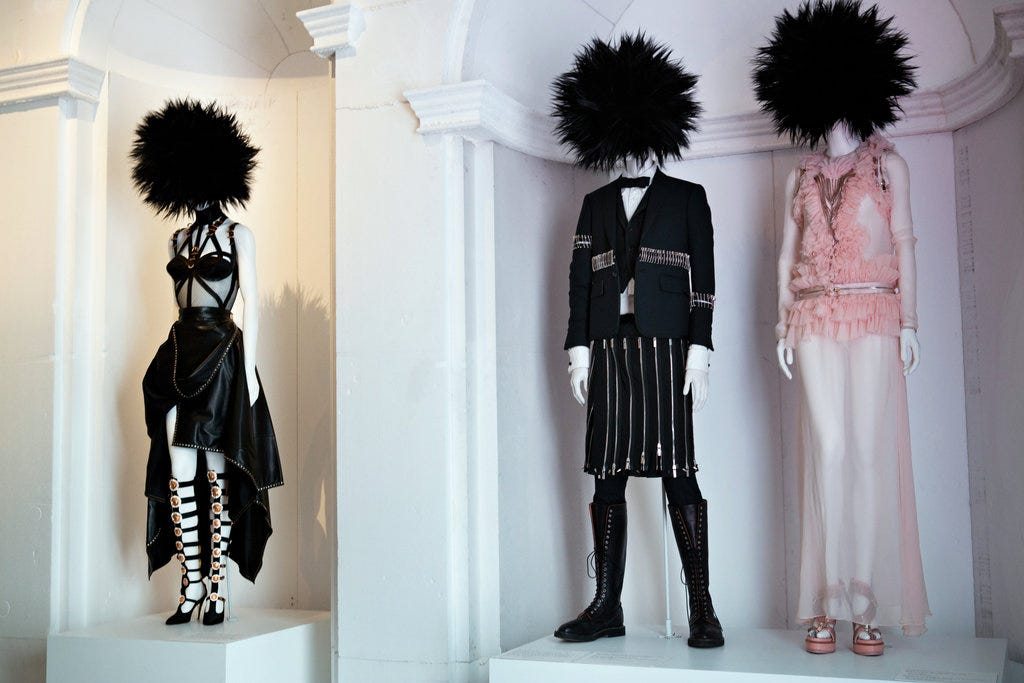 Paco Rabanne — French fashion designer who presented his first collection, Twelve Experimental Dresses, in 1964 and followed it in 1966 with a couture collection he called Twelve Unwearable Dresses. This sculptural micromini dress, constructed of square and rectangular aluminum plates joined with metal rings, is a rare surviving example from his “unwearable” collection. With its allusion to chain mail, the dress establishes Rabanne’s practice of citing historical elements in his space-age aesthetic. The innovative construction and unconventional use of material epitomize the exploratory and experimental sensibility of much 1960s avant-garde fashion.
Paco Rabanne — French fashion designer who presented his first collection, Twelve Experimental Dresses, in 1964 and followed it in 1966 with a couture collection he called Twelve Unwearable Dresses. This sculptural micromini dress, constructed of square and rectangular aluminum plates joined with metal rings, is a rare surviving example from his “unwearable” collection. With its allusion to chain mail, the dress establishes Rabanne’s practice of citing historical elements in his space-age aesthetic. The innovative construction and unconventional use of material epitomize the exploratory and experimental sensibility of much 1960s avant-garde fashion.
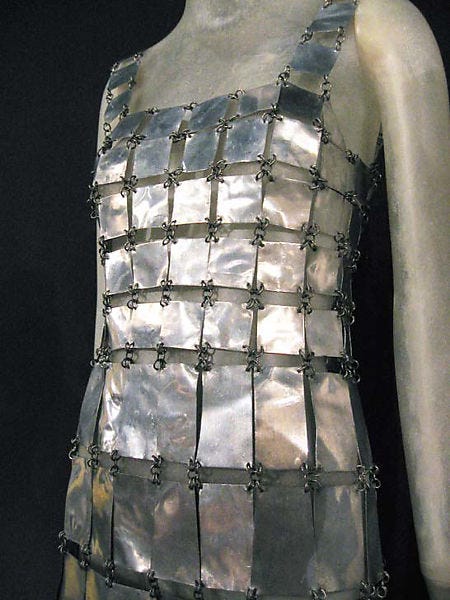
Pierre Cardin — Advances in fabric production and technology during the 1960s coincided with a widespread fascination with space exploration. Cardin’s Space Age or Cosmocorps collection of 1964 synthesized his streamlined, minimal dressing for both men and women. This body-skimming apparel resembling uniforms featured cutouts inspired by op art. Cardin was innovative in his use of vinyl and metal in combination with wool fabric. Not just unisex, Cardin’s clothing often seemed asexual. Unlike such other fashion minimalists as Rudi Gernreich and André Courrèges, Cardin did not promote pants for women. He often used monotone-colored stockings or white patterned tights to compliment his minidresses.
The “Long Longuette”, which was dubbed the maxidress, was Cardin’s 1970 response to the miniskirt. In 1971, Cardin obtained an exclusive agreement with a German firm to use its stretch fabric, declaring that “stretch fabrics would revolutionize fashion”. Continuing his reputation as a trendsetter, he showed white cotton T-shirts paired with couture gowns on the runway in 1974 and introduced exaggerated shoulders in 1979.
Cardin is known for his acute intuition, which often made him a trendsetter and design leader.
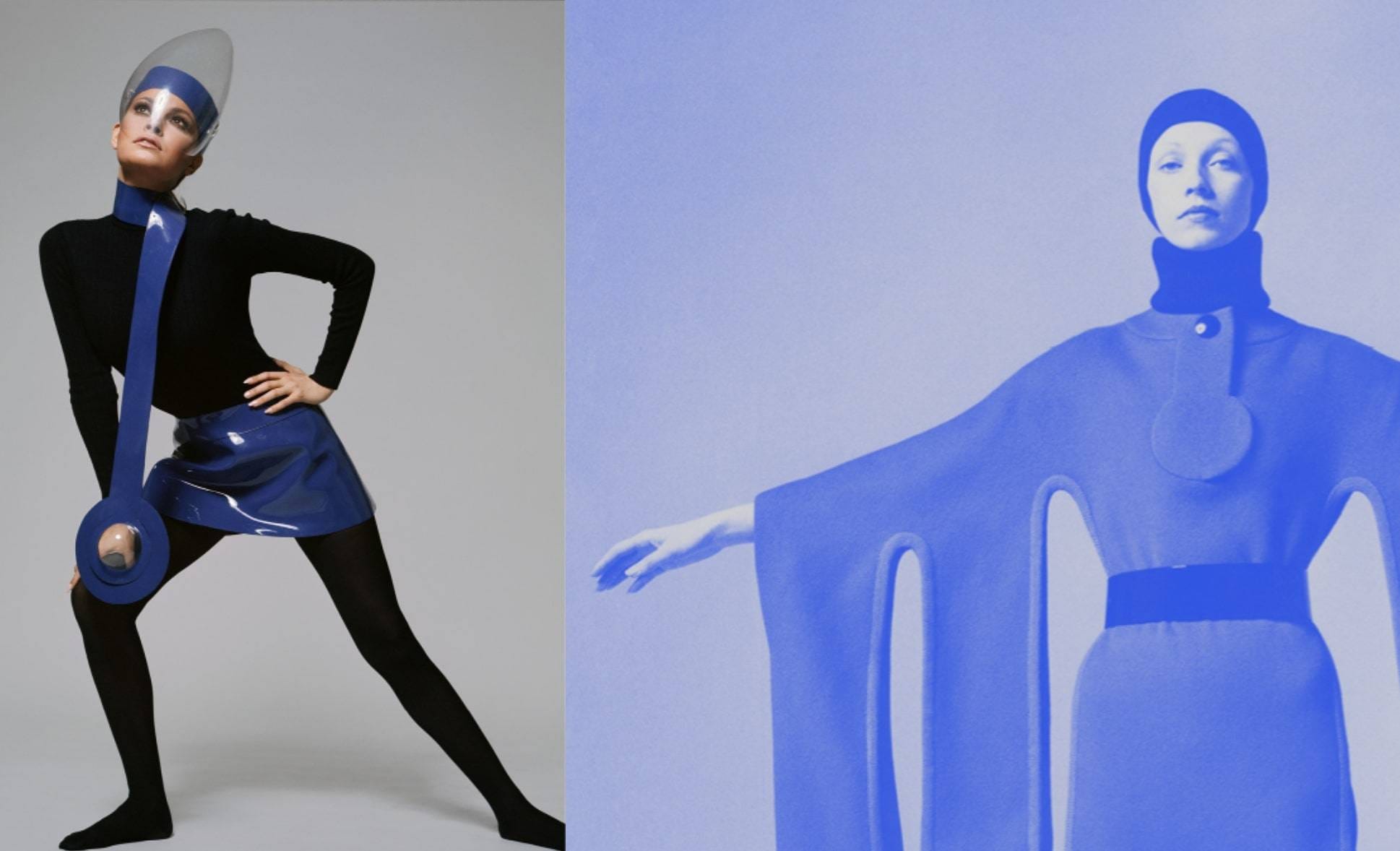 Hussein Chalayan — Turkish fashion designer known for his innovative mix of design, science and art in creating fantastical seasonal collections. His futuristic designs have included dresses containing moving airplane parts, a robot dress loaded with Swarovski crystals and Tyvek garments that resembled furniture and could be folded down to envelope size. They have been showcased in museums such as the Palais du Louvre, London’s Design Museum, the Metropolitan Museum of Art in New York and the Museum of Contemporary Art in Tokyo.
Hussein Chalayan — Turkish fashion designer known for his innovative mix of design, science and art in creating fantastical seasonal collections. His futuristic designs have included dresses containing moving airplane parts, a robot dress loaded with Swarovski crystals and Tyvek garments that resembled furniture and could be folded down to envelope size. They have been showcased in museums such as the Palais du Louvre, London’s Design Museum, the Metropolitan Museum of Art in New York and the Museum of Contemporary Art in Tokyo.

Issey Miyake — Japanese fashion designer. He is known for his technology-driven clothing designs, exhibitions and fragrances. Tradition is very important to Miyake. It is the fusion of the most basic of materials and ancient of traditions with new and innovative techniques that has kept his brand at the forefront of fashion — technically if not always critically — for the past four and a half decades.
Alexander McQueen — British designer. A genius of the runways. Alexander McQueen fashion presentations were ahead of the times. The first to use paint shooting robots at a dress, for the Spring 1999 show. The first to use holograms and even 3D printing techniques. Sadly, long before the emergence of the internet and improved 3D printing. Long before the world realized the sustainable issues we are facing, on February 2010, the acclaimed designer tragically passed away.
Iris van Herpen — Dutch fashion designer. Recognized as one of fashion’s most talented and forward-thinking creators who continuously pushes the boundaries of fashion design.
All of these designers and their collections are only a few of many examples of standstill moments through fashion tech history.
MATERIALS
3D Printing
3D printing has brought a fresh wave of innovation to runway shows and has great potential as a new mass-customization solution. Today’s 3D printing technologies are advanced enough to easily produce shoe soles and jewelry, but it’s still a relatively challenging process to 3D print a dress or a jacket.
Garments present one of the biggest challenges for designers to overcome, given that they need to be very flexible. For the most part, 3D printing is used for producing non-flexible parts. That’s why 3D printing fashion is a very expensive process still reserved for runway shows. Today, most 3D printed garments are typically built using mesh systems, which are individually 3D printed and later assembled.
Despite all of the challenges that come with 3D printed fashion, designers alongside engineers have managed to overcome many in order to produce some of their wildest designs. We’ll take a look at a few in this article.
3D printing, a technique employed most famously by Iris Van Herpen; Dutch fashion designer who creates garments that often feel like living organisms. “It has the potential to be as revolutionary as a sewing machine because if you get the materials correct, you could 3D print your own jacket or dress in your own home,” she said.
TIME Magazine named Iris Van Herpen’s 3D printed dress one of the 50 Best Inventions of the 2011. Always combining design with technology, Iris Van Herpen’s dresses are initially planned in Photoshop. She then works with an architect to develop a 3-D model, which is printed onto a polymer over the course of a week, resulting in a ready-to-wear dress that is an exact replica of the original sketched version.
Iris Van Herpen — who has been collaborating with Björk since 2011, designing different dresses all which started as a photoshop sketch design,
Their first collaboration was with the album called Biophilia: on the cover she wears an aubergine leather dress by the Van Herpen, intricately laser-cut and edged with golden foil to “underscore the hypersensitivity of the body and to visualize this entanglement of sensory perceptions” (the dress itself was titled ‘Synesthesia’).
 “It’s the ultimate couture, because couture is all about the fit.” — Iris Van Herpen
“It’s the ultimate couture, because couture is all about the fit.” — Iris Van Herpen
Glitter
Glitter took over as a trend, and for that there is always a why. This is a great article that dissects the history and euphoria on glitter. For all glitter lovers, I hate to break it to you but there is a dark side to loving glitter. Most glitter is being made from etched aluminium bonded to polyethylene terephthalate (PET), it is a form of microplastic, which can easily find it’s way into our oceans.
That is why BioGlitz has become so popular— BioGlitz produces the world’s first biodegradable glitter. Based on a unique biodegradable formula made from eucalyptus tree extract, the eco-glitter is fully biodegradable, compostable and allows for the sustainable consumption of glitter without the environmental damage associated with micro plastics.
ORGANIC MATERIALS
One of the greatest challenges faced by the textiles and fashion industry is to make itself more sustainable, not just in terms of economic and labor-force issues but in the face of ecological necessity. The production of textiles involves a long chain of complex processes to convert raw materials such as fibers or petroleum into finished fabrics or fashion products.
Can organic materials represent a new mode of survival?
Suzanne Lee is the founder and CEO of Biocouture, a platform nurturing collaboration for design and biology to grow the future of sustainable materials for consumer products. Biocouture envisions future manufacturing systems inevitably consisting of biodesigned living organisms, forming engineered materials directly into finished, biodegradable products, and is focused on that goal.
Enzymes are highly specific biocatalysts found within the cells of all living organisms. They offer the possibility of manufacturing textiles using simpler and less severe processing conditions, which can reduce the consumption of chemicals, energy, and water and the generation of waste. As a result, enzymes have successfully replaced a range of industrial textile processes, since they started being used in the early part of the 20th century.
Cow manure: In a circular economy model, nothing is considered waste. In the Netherlands, a company called Inspidere has developed a method it calls Mestic that uses cow manure to produce new textiles. The processing method enables cellulose to be extracted from manure to produce two materials, viscose and cellulose acetate.
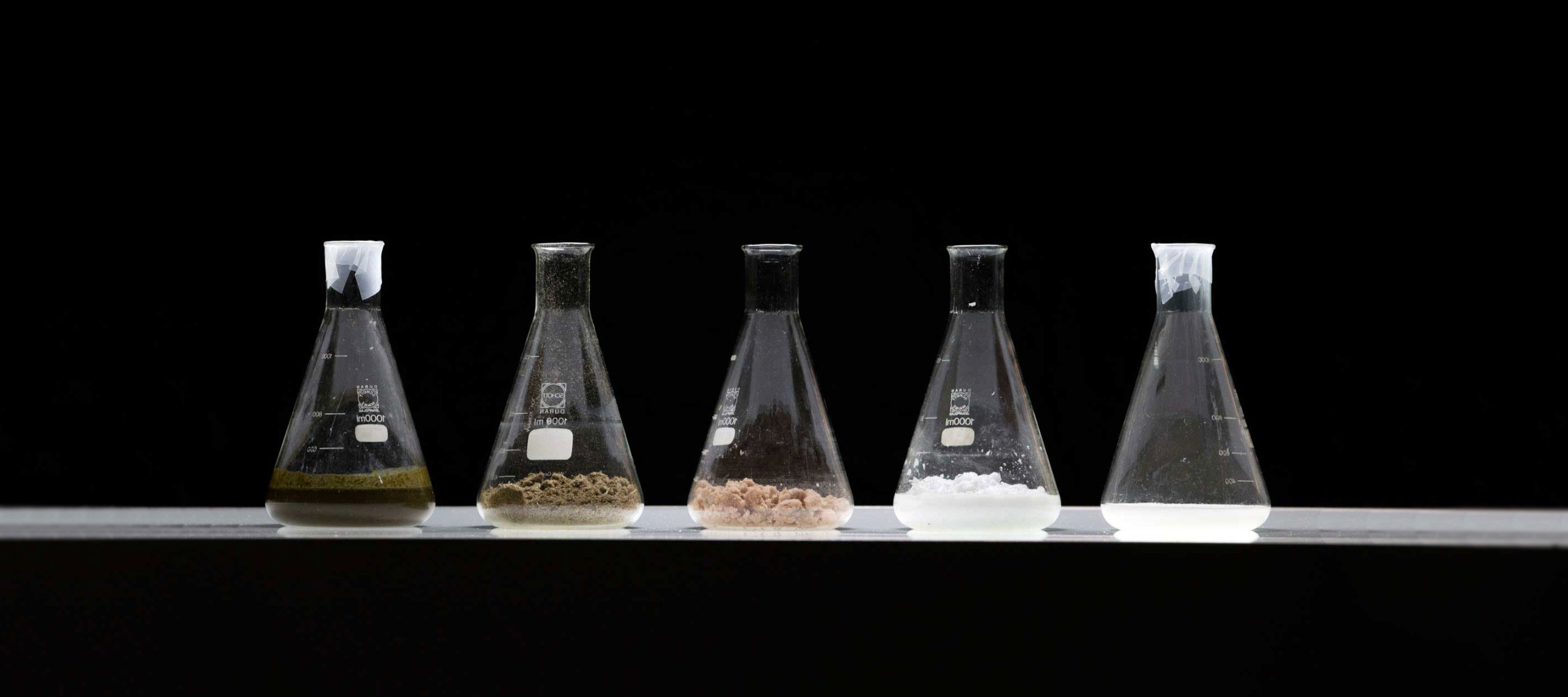
The manure is separated and processed in a lab to extract pure cellulose, which is further processed to create viscose (regenerated cellulose) and cellulose acetate (bio-plastic), both of which can be turned into textiles. The group has achieved lab-scale success; the challenge remains to scale this process up commercially.
Similar inspiration to Inspidere, Israeli designer Shahar Livne has designed a pair of sneakers with alternative leather inserts made from the wasted fat, bones and blood of animals.
Inspired by the “nose to tail” attitude of using the entire animal, Livne also used discarded blood as an ink-like colourant and plasticiser for the deep-red material. The materials used are intended to spark a conversation about where our food comes from.
 Shahar Livne is an award winning conceptual material designer located in Eindhoven, The Netherlands. Her lifelong fascinations in nature, biology, science, and philosophy developed into intuitive material experimentation way of work during her bachelor studies at the Design Academy Eindhoven.
Shahar Livne is an award winning conceptual material designer located in Eindhoven, The Netherlands. Her lifelong fascinations in nature, biology, science, and philosophy developed into intuitive material experimentation way of work during her bachelor studies at the Design Academy Eindhoven.
Grass roots: An interesting project by the artist Diana Scherer called Interwoven explores the fabrication of materials using living plant networks, which could be used to construct garments of the future. She has developed a process which manipulates oat and wheat plant roots to grow intricate lace-like textile materials.
From fungi: Similarly, San Francisco-based MycoWorks has been exploring the possibilities of creating sustainable materials using fungi. Mycelium (a mushroom root material), which is grown from fungi and agricultural byproducts, is custom-engineered in a lab using a carbon-negative process.
It is easy to cultivate, fast-growing, and can be easily manipulated to adopt properties similar to leather and many other mainstream materials such as wood and polystyrene. 
Another interesting example, Cocoon Biotech and Spintex Engineering; two technology startups working on recycled silk. CEO Ailis Tweed-Kent says Cocoon Biotech is in early discussions with fashion houses to collaborate on recycling used and excess silk; that could find not only a second life in fashion but also in consumer health products like skincare and eye drops.
OUR PRODUCT MATERIALS
Recycled Polyester: a green, sustainable alternative to virgin polyester
Unlike polyester, recycled polyester uses PET as the RAW material. This is the same material that is used in clear plastic water bottles, and recycling it to create the fabric prevents it from going to landfill.

Textile recycling technology has immense scope where polyester is concerned. This technology has nominal waste, consumes limited energy and causes very little pollution.
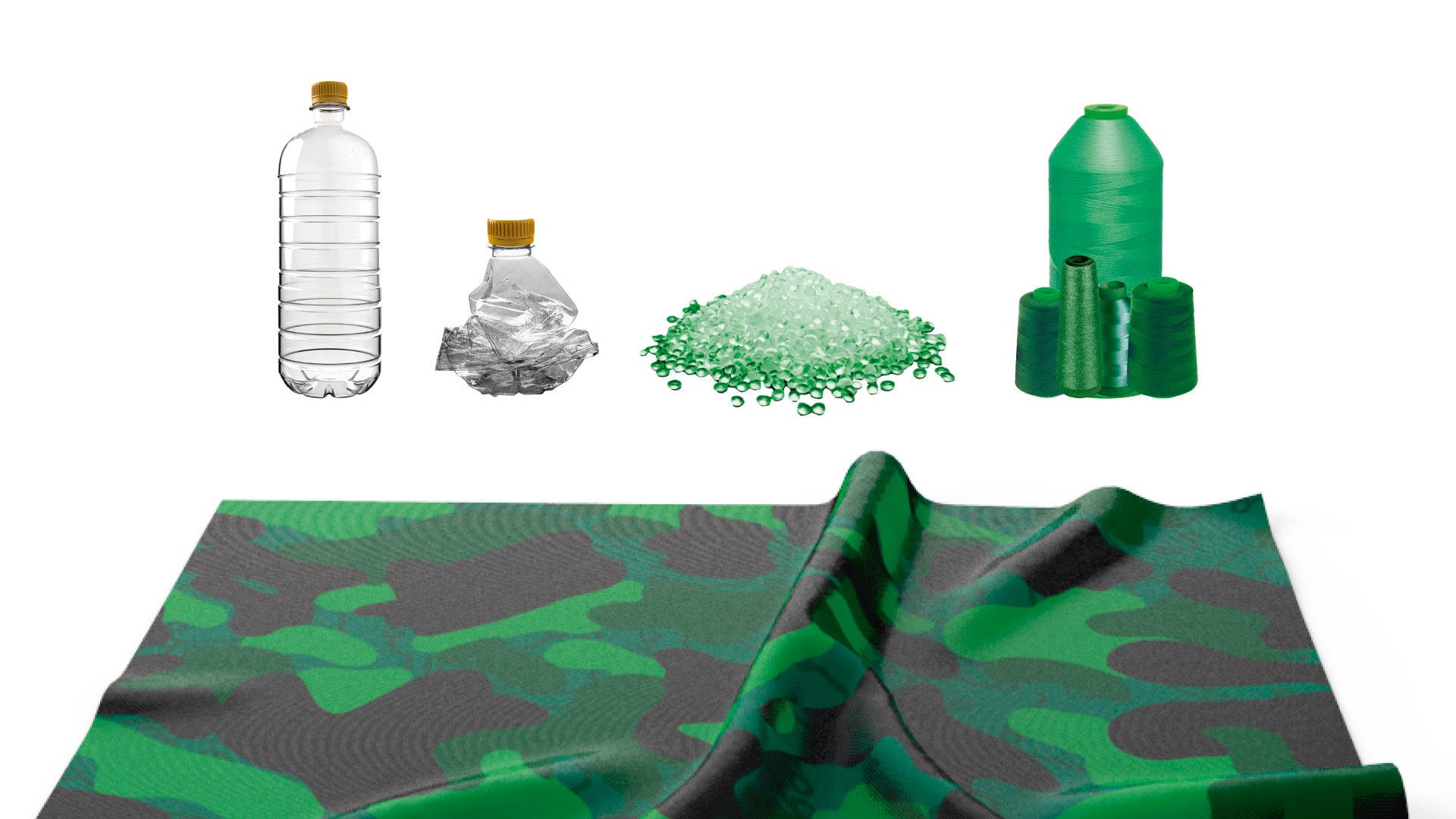
♻️ You can purchase all of our products made from this recycled polyester here.♻️
Ever imagine that the coffee we drink is transformed into the apparel we wear? With a low-temperature, high-pressure and energy saving process S. Café ® technology combines coffee grounds onto the yarn surface, changing the characteristics of the filament, and offers up to 200% faster drying time compared to cotton. S.Café ® fabrics will provide excellent odor control, UV protection and fast drying benefits.
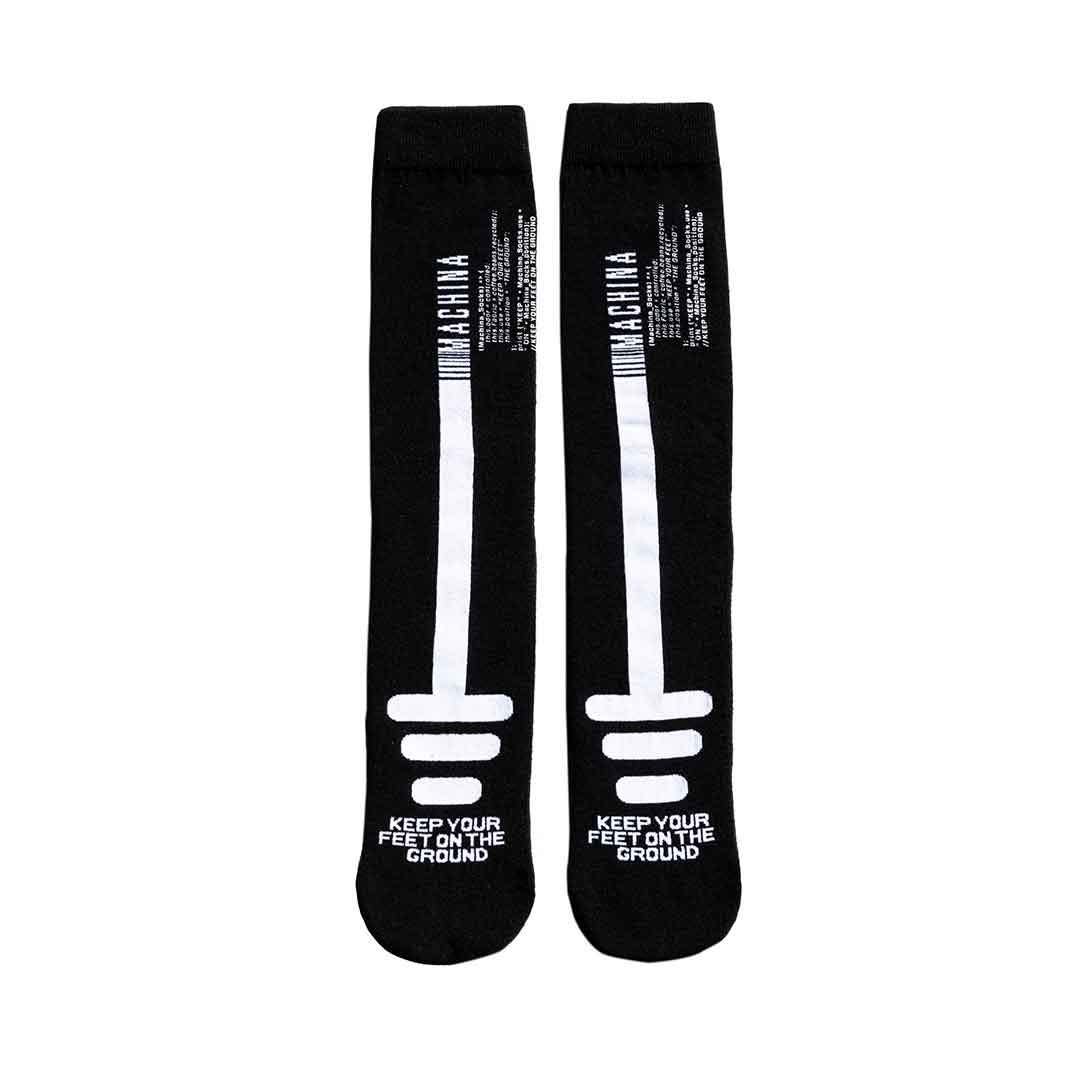
Unisex MACHINA socks now available
♻️ Purchase our black signature unisex MACHINA socks.♻️
These are just a few of the ways in which nature is being harnessed to provide the textile and fashion industry with realistic and viable options to move towards sustainability.
MANUFACTURING
Sewing machine innovations have reached a gorgeous climax with laser cutting machines, fusing machines, button hole machines and much more.
Chinese apparel company, Tianyuan Garments Co., recently opened a $20 million factory in Little Rock, Arkansas. The factory employs 400 people, but also utilizes 24 robots, known as “Sewbots,” from Atlanta company, Softwear Automation Inc. The Sewbots are capable of producing one t-shirt every 30 seconds without the aid of human hands. The company estimates it will produce roughly 23 million shirts per year at a cost of $0.33 per shirt.
The discussion for man vs machine has been going on for a while now, way before the Terminator.
Because machines are much easier to measure. They produce data and communicate with each other efficiently. For example, it’s relatively simple to get outputs on efficiency, accuracy and precision from an industrial 3-D printer. Overall Equipment Effectiveness measurements on various machines on the factory floor are easily available.
Try doing that with people. The data to help understand how well humans are performing simply doesn’t exist. The best manufacturers have to work with is a tiny sample set gathered with a stopwatch and clipboard while observing a line on the floor. Too many skilled industrial engineers, who were educated and trained to make key operations decisions that improve plant metrics, are spending time gathering this data.
Automation, AI and robots have not only arrived in the world of manufacturing, the speed at which innovation occurs within these areas is also increasing. A machine may perform a tedious and/or dangerous task, while creating a new, higher-level job for a human as an operator, engineer or technician. Although full automation in the apparel manufacturing still has a long way to go, there are examples like Tianyuan Garments Co. and Google who want to be the first in evolving this industry.
Google has bought almost every machine-learning and robotics company it can find and already won a patent to start building worker robots. They have bought Boston Dynamics, the firm that produces spectacular, terrifyingly life-like military robots, for an “undisclosed” but undoubtedly massive sum.
There are plenty of examples of humans being augmented by technology in our daily lives. The same is true for machines augmenting humans.
Thus being said, manufacturers today need to facilitate a cultural shift toward the “human + machine” mindset. This can be done through education, training and appreciation.
RETAIL
Today’s headlines are full of stories about retail apocalypse and having stores forever to be shut down like Barney’s, Forever 21, Henri Bendel, Sears and more; and in the other hand we constantly see in the news and events technology disrupting the retail industry — from robots and drones in stores, to mobile self-checkout and “scan & go” models, to a major European supermarket chain using blockchain to track milk.
An interesting example of robots and interactive apps in the retail space is Alibaba’s Hema — the online shopping experience taken to offline to revolutionize your supermarket experience.
There is a high demand for convenience and experiential shopping environments, today’s customers are omnichannel shoppers. Meaning, they will tap both online and offline retailers to complete their shopping or visit both retail environments before making a single purchase through one of the channels.
Retailers are now experimenting with Virtual Reality, personalized shopping through personalized dressing rooms, robots and more. However, when it comes to online brands, the physical versus the virtual shopping experience is no longer an either-or proposition. For today’s marketer, synergy between the two is key, and understanding consumer trends in real life are essential to delivering them the products and experiences that will earn their loyalty for life.
CONCLUSIONS
The word “technology” tends to conjure up digital, software-based devices, from iPhones to self-driving cars. But, for some, the term “tech” also carries another meaning: a way of thinking, rooted in the iterative, test-and-learn approach to creativity and innovation favoured by those making the devices. Perhaps this is why, nowadays so many fashion brands talk about thinking like a technology company. “It’s about how fast tech companies are, but also how creative they are,” Anna Wintour told BoF.
Technology companies, which are totally consumer-centric, have changed the way we relate to brands. The Apple Watch is a great example of a technology company adapting into everyday lifestyle. Many fashion companies, on the other hand, still have a tendency to create an aspirational lifestyle and assume that if the consumer wants to be part of that, they will just follow the brand.
Trends are no longer dictated by high-end designers or runway shows. Being constantly bombarded with new information by the minute, consumers get their inspiration in many different ways, meaning the nature of design is changing radically and irrevocably as it is influenced by more sources than ever before.
In manufacturing, we are seeing wages rise in countries that historically provided the West with cheap labour. Combined with a perceived consumer desire for sustainability and ethical sourcing, and new tech-driven production methods, what manufacturing looks like is up for grabs and conditions could be ripe for a renaissance in British industry.
To a viewer, the arrangement — which essentially documents the process of engineering a garment, either by hand, by machine or a combination of both — feels orderly, almost zen-like. Fashion is going so fast, it’s fast to keep up with it’s development and even consumption. There is no a appreciation of the artists, designers, and all the complicated processes that goes behind building any kind of garment. in MACHINA our objective is having our customers slow it down a little bit and have people focus on the making of fashion and appreciate the process behind it. This is a reason why we do not launch a collection every two months as other designers do. Check out our latest collection here.
At the same time, technology companies are increasingly adopting the lessons — and language — of fashion. “Regardless of whether we declare an interest in fashion or not, we are making products that are more and more personal… products that you wear and you wear every day,” Chief Design Officer Jonathan Ive said regarding most of Apple products. “We’ve not done that before and we’ve got a lot to learn.
For any brand, iteration is essential to staying ahead in today’s ever-changing world.
Technology has overtaken all of our lives in some way or another. It has changed all that we have done and all that we will do in years to come. The true interplay of technology and fashion has only just begun.
“Fashion will renew itself through technology, new fibers, new ways of making clothes. Without risk, nothing changes the world.” — Hussein Chalayan





